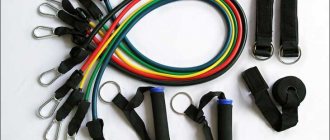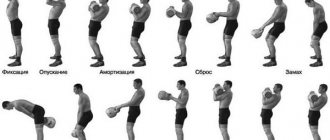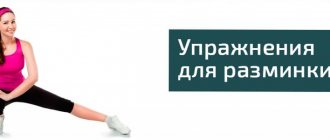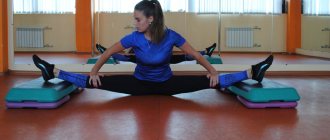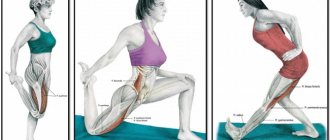Fitness bands are the simplest sports equipment and one of the most inexpensive and convenient ways to train at home. They allow you to “pump up” all the main parts of the body - arms, legs, hips and buttocks. The good thing about elastic bands is that they give an effective result and take up minimal space, so you can always take them with you. In general, this is an ideal option for those whose “home gym” is the space between the sofa and the TV.
Although there are a million ways to do the resistance band exercise, they are especially good for the legs and buttocks. If you need an effective home workout for weight loss, try these leg exercises with elastic bands, which will help you quickly get into shape if you do them comprehensively and regularly.
Jumping with changing leg position
Place a resistance band around your ankles. Stand in a quarter squat (lower squat), with your feet hip-width apart and your arms bent at the elbows and held at your chest. Start jumping with your feet together, feet apart. Do 20 reps. Try not to jump too high and land on your heels rather than your toes.
Useful tips
Before you start exercising with a fitness band, you need to conduct a brief self-analysis and decide on the points listed below.
Setting goals and results
As in all endeavors, when preparing for training with a fitness elastic band, first of all, you need to decide on the purpose and desired result of the training.
Namely:
- lose weight;
- gain muscle mass in general;
- work out certain muscles, for example, pump up your buttocks or legs;
- restore old injuries;
Choosing a fitness band
To choose an expander, you first need to pay attention to the degree of resistance. For beginners, an expander with minimal resistance is suitable. For a person with training - medium hardness or hard tapes. Highly rigid tape expanders with maximum resistance are designed for athletes.
It is customary to distinguish expanders by color:
- yellow – soft elastic bands for beginners;
- red – soft;
- green – medium hard elastic bands;
- blue – hard;
- black ones are very hard.
But, you need to keep in mind that often the manufacturer independently determines the palette, so you should check the labeling. For beginners, it is better to buy a set of five fitness bands.
Decide on time
To achieve the desired result, you need to decide how much time you plan to devote to training. For a beginner, training for half an hour 2-3 times a week will be sufficient.
Frequent training is not recommended, since due to intense training, the body does not have time to recover in a short time. As a result, the result will be minimal, and the body will experience stress. As you master the expander, you can increase the duration and load of classes.
Determine your fitness level
It is necessary to evaluate the capabilities of your body. In addition, it would not be superfluous to consult a doctor.
Preparing for the exercises
Before you immediately start training with a fitness band, you should warm up and do some stretching. Warm-up is needed to prepare your body for physical activity. It helps to warm up the muscles to avoid injuries and strains, and also to perform exercises with the greatest efficiency.
If you warm up well before exercise, blood circulation improves, muscles are saturated with oxygen, and accordingly, endurance during exercise increases. Therefore, you should not neglect warming up, as this can cause negative consequences. Warm-up time can be 10-20 minutes.
Safety rules for using fitness elastic bands
Scroll:
- You should absolutely not let go of a stretched fitness band.
- You cannot stretch the elastic 2.5 times its own length.
- It is not recommended to exercise with expanders on an uneven surface, so as not to lose your balance during training.
- It is necessary to start classes with slow movements with a gradual increase in tension force.
Recommended elastic bands for fitness based on reviews on the Internet
Thanks to reviews on the Internet, you can familiarize yourself with and choose the appropriate set for classes. Examples of expanders with good reviews are presented in the table.
Recommended sets of fitness bands:
| Brand | description | compound | price, rub.) |
| U-POWEX | Set of 5 resistance bands | 100% latex | 1300 — 1700 |
| Esonstyle | Set of 5 fitness bands | rubber, artificial latex | 850 — 1000 |
| Go Do It | Basic set of 5 fitness bands for beginners | 100% natural latex | 1200 — 1500 |
| Atletika24 | Set of 5 ribbons | 100% natural latex | 1000 — 1600 |
| Zoe Dundee | Set of 4 resistance bands | 100% natural latex | 900 — 1300 |
Walking to the side
Place the elastic around your ankles. Stand in a quarter squat (lower squat) with your feet hip-width apart and your hands at chest level or on your hips. Take 2-3 steps to the right with your right foot so that your feet are shoulder-width apart. Then repeat the same on the left side. Do 20 repetitions - 10 times on each leg. During the exercise, try to keep your body straight, without leaning to the side, keep your buttocks tense, and your lower back engaged.
Essence and basic principles
Fitness elastic bands are elastic bands for the legs made of a special material with different densities. They are also called expanders. Basically, expanders are made from 100% latex. It is necessary to take into account that latex varies in quality, which depends on the country of origin - Malaysia, Thailand or China.
Latex produced in Malaysia is considered to be of the highest quality. It has high elasticity and strength, which makes it many times more wear-resistant than, for example, Chinese latex. Depending on the density of the expander, the load is determined. The tighter the elastic, the stronger the resistance, and accordingly, the greater the load on the body.
In addition, it is convenient to use at home; the fitness elastic band is an excellent alternative to barbells and dumbbells, while being safe and easy to store. There are different types of fitness bands. Some are designed to pump up the legs and buttocks, others are designed to strengthen the muscles of the arms and back.
Exercises with elastic bands for legs can be performed even by beginners. They are not only safe and healthy, but are also considered one of the most effective ways to pump up your body in a short time.
Using expanders for training has a number of advantages:
- the load is evenly distributed over the entire trained area of the body;
- the risk of injury is minimal, practically eliminated;
- multifunctionality and versatility - exercises with an expander help to work out different muscle groups, including helping to rehabilitate various injuries;
- the body becomes more elastic, problem areas of the body are smoothed out;
- compactness;
- the ability to train at home without going to the gym;
- low cost.
Despite the number of advantages, fitness elastic bands have small disadvantages that need to be taken into account when purchasing this sports equipment.
Namely:
- thin elastic bands quickly wear out and tear;
- narrow elastic bands dig into the skin and cause pain and discomfort;
- Possible allergy to latex.
Fitness elastic bands are divided into the following types:
- elastic bands 1.2 - 2 m long, 5 cm wide;
- mini-loop approximately 60 cm long, 5-10 cm wide;
- long loop 1.5 - 2 m long, 2-10 cm wide, suitable for athletes;
- eights;
- ring;
- exertube.
The most popular type of fitness band is the elastic band. It is in great demand because of its versatility. It can be used in all exercises to work any muscle group. The mini-loop is considered the most convenient and safe to use. Does not compress blood vessels, does not rub. Effective for pumping up the abs.
Using a long loop is convenient because the range of movements can be increased due to its length. But you need to have a certain physical fitness to train with this type of elastic band. Eights are suitable for working the muscles of the thighs, buttocks and forearms. The ring pumps up the biceps and triceps well. Exertube is suitable for strengthening the muscles of the back and arms.
According to the composition of the material, fitness elastic bands are distinguished:
- latex;
- fabric;
- polyurethane;
- rubber.
Latex expanders are the most popular today. They stretch well, but can cause allergies. Fabric elastic bands contain natural fabrics with the addition of polyester or latex. The advantage of a fabric elastic band is that while performing exercises, it does not slip off the body. The disadvantage is that it rubs the skin.
If you are allergic to latex, then a polyurethane fitness elastic band will be a good alternative. It is hypoallergenic and has good wear resistance. The main disadvantage is the high price compared to elastic bands made from other materials.
If you need an inexpensive expander, you can buy a rubber one, but you need to keep in mind that such an elastic band quickly wears out and loses its rigidity.
Exercises with elastic bands for legs can be performed at home, which is undoubtedly an advantage of this sports equipment. The principle of working with such tapes is that when they are stretched, the load on the legs occurs due to resistance.
It is not recommended to exercise with an expander every day, since in a short period of time the muscles will not have time to recover, which can be harmful to health. In addition, you should pay attention to the execution technique in order to achieve the desired results in a relatively short time.
Exercises with elastic bands for your legs will help you achieve the following:
- weight loss (for those who want to lose weight);
- gaining muscle mass (for those who want to gain muscle mass);
- improving body elasticity;
- increasing muscle resistance;
- restoration of injured muscles and joints.
Taking the leg back
Place a resistance band around your ankles. Keeping your hands at chest level or on your hips, transfer your weight to your left leg and take your right leg back about 20-30 cm from the floor, lowering your foot only to the tips of your toes. During the exercise, keep your abs and buttocks tense, keep your back straight, and your knees should be pointing straight. You should feel good resistance in the elastic band. Do the set 20 times, then change legs and repeat the same.
To make the training even more effective, also add leg abduction to the side and diagonally to the back swings. These exercises with elastic bands will help you work out the back of your thighs and tighten your buttocks.
Benefits of fitness bands
Fitness bands are not only an excellent alternative to traditional machines and dumbbell bars in terms of efficiency, but they are also a much safer alternative because they do not place axial stress on your back and spine. Well, the variety of existing exercises and the ability to adjust the load within a wide range have made this equipment very popular not only among fitness enthusiasts, but also among professional athletes, who especially often use them during recovery from injuries.
Not only do fitness loops allow you to perform resistance exercises, in which they can replace traditional dumbbells, but they can also be used as additional resistance in bodyweight exercises, such as push-ups, squats and lunges, which are especially popular today. popular. Fitness bands also take up very little space, so you can easily take them with you to the outdoor area or on vacation.
Well, in today’s article we will show you a set of exercises for all major muscle groups that will help tighten your buttocks, get rid of flabby arms, and also pump up your back. Just 15 exercises, half an hour of time, 3 workouts per week, and the results will not keep you waiting!
Walking at an incline
Place the elastic band around your ankles. Stand with your feet shoulder-width apart. Bend your knees a few centimeters, bend your arms at chest level, and lean your torso forward, as shown in the example. Keep your abs and buttocks tight. Take 10 steps forward and 10 steps back. During the exercise, keep your back straight and your shoulders back.
Get started now! Motivation for losing weight
Squats with leg abduction
Secure the elastic band on your hips, just above your knees. Stand with your feet shoulder-width apart and keep your hands at chest level or on your hips. Bend your knees, push your buttocks back and do a deep squat. Step back and step your right leg out to the side, keeping your knee straight, then lower your leg to the floor. Repeat the squat again, but this time repeat the trick with your left leg. Do 20 reps, alternating both legs.
First stage: Warm-up
Before warming up, stretch the joints of your arms, feet, and neck.
Exercise 1.1: Lateral bends with a fitness band
(15 times on each side - 2 sets)
Exercise 1.2: Stretching a fitness elastic band on the right and left hand
(15 times on each hand - 2 approaches)
Exercise 1.3: Push-ups with a fitness band
(15 times - 2 approaches)
Exercise 1.4: Jumping frog with fitness bands
(1 minute - 2 approaches)
Exercise "shell"
Place the band just above your knees. Lie on your side, resting your head on the hand that is closest to the floor, or supporting it with your hand bent at the elbow, as shown in the example above. Raise your legs to hip height, keeping your knees flat on the floor. Keeping your legs together, begin to move your top knee toward the ceiling and slowly lower it down without crossing your legs (the knee should be suspended). Do 20 reps and then switch sides. This is a good exercise to warm up before doing lunges or squats.
What fitness bands will you need for exercise?
Fitness bands are elastic latex bands for training, made in the shape of a ring. They provide additional stress to the muscles through resistance and may also be called resistance bands, bands or loops.
Fitness bands vary in length: there are short mini-bands, the total length of which is 60 cm, and longer models - up to 200 cm.
A set of mini elastic bands for fitness. Photo: Ozon
If you plan to train only your buttocks, you can limit yourself to mini bands. If in the future you want to load other muscle groups, then you should buy long ones.
The range of exercises with such expanders is much wider: with them you can do push-ups and pull-ups, do presses, fly-ups and rows, and also use them as mini-elastic bands, simply tying them with a knot in the middle.
A set of long elastic bands for fitness. Photo: AliExpress
Also consider the resistance of the band machine. Typically, the specifications indicate the load that you will receive when training with a specific model. This parameter can be specified in kilograms or pounds and is designated as “elasticity”, “maximum load”, pulling force.
To train the gluteal muscles, elastic bands with a load of about 9–15 kg are suitable. You can buy one, but keep in mind that the load should increase over time, so you will either have to do more repetitions or buy a resistance band with more resistance.
Therefore, it is still better to immediately purchase a set of several rubber bands. This way you can more accurately regulate the load and train not only the buttocks, but also other parts of the body.
What to buy
- Set of mini elastic bands for fitness with Ozon →
- A set of mini elastic bands for fitness from AliExpress →
- Set of long expanders from AliExpress →
Raising legs on all fours to the side
Place the elastic band slightly above your knees. Get on all fours, placing your knees hip-width apart and your hands exactly shoulder-width apart. Your knees should be bent at right angles and your hips vertical. Without moving your hips or changing the position of your pelvis, move your left knee to the side, keeping it bent. Slowly return your leg to the starting position. Repeat 20 times and then repeat the same on your right leg.
Raising legs on all fours back
Secure the elastic band around your left foot and right ankle as shown above. Get into a pose on all fours with your knees level with your pelvis and your arms extended exactly shoulder-width apart. Raise your left leg up, bent at the knee. Hold it in this position for 2 seconds (longer if you can), and then return it to the starting position. Continue this 20 times, then change legs and repeat again.
Exercise No. 3. Side steps in a half squat
- Stand up straight. The back is straight, the gaze is directed forward. Place the elastic band above the knee or in the ankle area. Depending on your level of preparation. The second option is a little more difficult to perform.
- Move your pelvis back a little so that your body is in a half-squat position. Keep your arms in front of you or at your sides for balance.
- In a half-squat position, start taking steps in one direction, then in the opposite direction.
Perform 2 sets of 12-15 steps in each direction.
